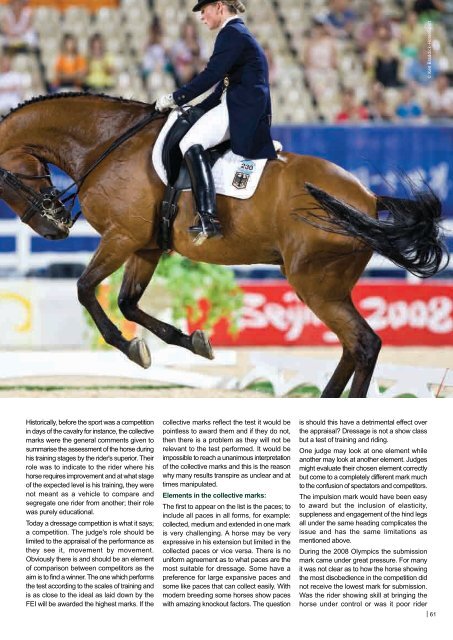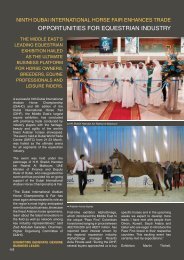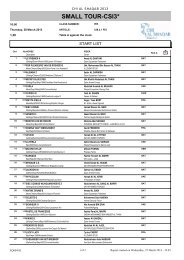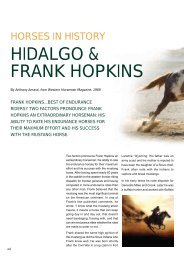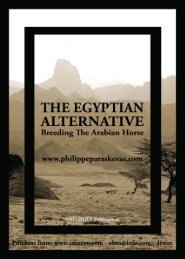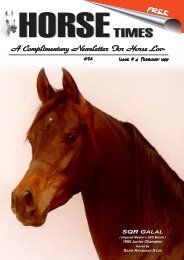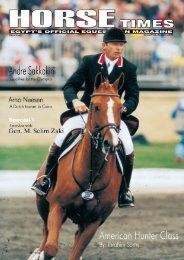hrh princess haya bint al hussein hrh princess haya ... - Horse Times
hrh princess haya bint al hussein hrh princess haya ... - Horse Times
hrh princess haya bint al hussein hrh princess haya ... - Horse Times
You also want an ePaper? Increase the reach of your titles
YUMPU automatically turns print PDFs into web optimized ePapers that Google loves.
Historic<strong>al</strong>ly, before the sport was a competition<br />
in days of the cav<strong>al</strong>ry for instance, the collective<br />
marks were the gener<strong>al</strong> comments given to<br />
summarise the assessment of the horse during<br />
his training stages by the rider's superior. Their<br />
role was to indicate to the rider where his<br />
horse requires improvement and at what stage<br />
of the expected level is his training, they were<br />
not meant as a vehicle to compare and<br />
segregate one rider from another; their role<br />
was purely education<strong>al</strong>.<br />
Today a dressage competition is what it says;<br />
a competition. The judge's role should be<br />
limited to the apprais<strong>al</strong> of the performance as<br />
they see it, movement by movement.<br />
Obviously there is and should be an element<br />
of comparison between competitors as the<br />
aim is to find a winner. The one which performs<br />
the test according to the sc<strong>al</strong>es of training and<br />
is as close to the ide<strong>al</strong> as laid down by the<br />
FEI will be awarded the highest marks. If the<br />
collective marks reflect the test it would be<br />
pointless to award them and if they do not,<br />
then there is a problem as they will not be<br />
relevant to the test performed. It would be<br />
impossible to reach a unanimous interpretation<br />
of the collective marks and this is the reason<br />
why many results transpire as unclear and at<br />
times manipulated.<br />
Elements in the collective marks:<br />
The first to appear on the list is the paces; to<br />
include <strong>al</strong>l paces in <strong>al</strong>l forms, for example:<br />
collected, medium and extended in one mark<br />
is very ch<strong>al</strong>lenging. A horse may be very<br />
expressive in his extension but limited in the<br />
collected paces or vice versa. There is no<br />
uniform agreement as to what paces are the<br />
most suitable for dressage. Some have a<br />
preference for large expansive paces and<br />
some like paces that can collect easily. With<br />
modern breeding some horses show paces<br />
with amazing knockout factors. The question<br />
is should this have a detriment<strong>al</strong> effect over<br />
the apprais<strong>al</strong>? Dressage is not a show class<br />
but a test of training and riding.<br />
One judge may look at one element while<br />
another may look at another element. Judges<br />
might ev<strong>al</strong>uate their chosen element correctly<br />
but come to a completely different mark much<br />
to the confusion of spectators and competitors.<br />
The impulsion mark would have been easy<br />
to award but the inclusion of elasticity,<br />
suppleness and engagement of the hind legs<br />
<strong>al</strong>l under the same heading complicates the<br />
issue and has the same limitations as<br />
mentioned above.<br />
During the 2008 Olympics the submission<br />
mark came under great pressure. For many<br />
it was not clear as to how the horse showing<br />
the most disobedience in the competition did<br />
not receive the lowest mark for submission.<br />
Was the rider showing skill at bringing the<br />
horse under control or was it poor rider<br />
© Ken Braddick-<strong>Horse</strong>Sport<br />
61


